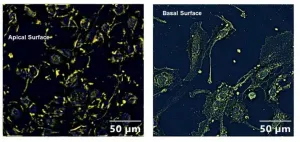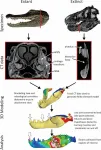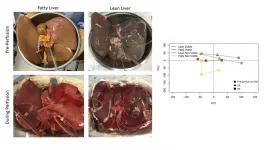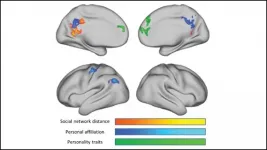Surgical procedure may help restore hand and arm function after stroke
International, multi-center clinical trial results provide new hope for patients even years after a stroke
2021-04-26
(Press-News.org) LOS ANGELES -- Every year, more than 795,000 people in the United States have a stroke. Of these, approximately 80% lose arm function and as many as 50-60% of this population still experience problems six months later.
Traditionally, stroke patients try to regain motor function through physical rehabilitation, where patients re-learn pre-stroke skills, such as eating motions and grasping. However, most patients eventually plateau and stop improving over time.
Now, results of a clinical trial published in The Lancet gives patients new hope in their recovery.
Patients who received a novel treatment that combines vagus nerve stimulation (VNS) and rehabilitation showed improvement in upper body motor impairment compared to those who received sham (inactive form of) stimulation and rehabilitation. Considered a natural antenna to the brain, the vagus nerve runs from the chest and abdomen to the brainstem and regulates many of the body's functions.
"This is incredibly exciting news for everyone involved in stroke rehabilitation and functional restoration and represents a unique intersection between neurosurgery and neurorehabilitation," said Charles Liu, MD, PhD, the lead neurosurgeon of the study and director of the USC Neurorestoration Center of Keck Medicine of USC. "These study results are the first of their kind, and open up new possibilities for stroke patients, allowing them to reclaim more arm function even years after having a stroke."
In this international, multi-center clinical trial, 53 participants with moderate to severe arm weakness nine months to 10 years post-stroke, received rehabilitation paired with VNS. Fifty-five patients within the same parameters received a sham stimulation. The trial was randomized and triple blind.
Those receiving the nerve stimulation had a wire inserted into their neck that wrapped around the vagus nerve. The wire was then connected to a pulse generator device implanted in the chest. Those receiving the sham received placebo implants.
After the surgical procedure, all patients received six weeks of in-clinic therapy, which included tasks such as reaching and grasping, simulated eating and opening and closing containers. After the in-clinic period, patients continued treatment with a course of daily home therapy.
When the two patient groups were compared, those receiving the nerve stimulation scored higher on several standardized measures of upper arm functionality.
"Not only were the results clinically meaningful, the fact that these patients were at least nine months post-stroke and in some instances years out, points to the possibility that meaningful improvements can be achieved even years after a stroke," said Liu, who also serves as chief of innovation and research and chair of neurosurgery and orthopedics at Rancho Los Amigos National Rehabilitation Center.
The device is thought to work by triggering the release of brain neuromodulators - which regulate the body's responses - to strengthen motor circuits in the brain associated with movement, enabling the brain to effectively relearn tasks. VNS is already used widely for the treatment of epilepsy and plays an increasing role in the treatment of severe depression.
"For too long, stroke patients have faced limited options for recovery," said Liu. "This new treatment signifies a breakthrough that could be life-changing for many stroke patients and also represents an approach that will certainly be explored for many other functional restoration applications in the future."
INFORMATION:
The VNS system utilized for the study is owned by MicroTransponder Inc., a medical device development company, who sponsored the study.
Lead authors on the study include Jesse Dawson, MD, College of Medical, Veterinary and Life Sciences, University of Glasgow in Scotland; Teresa J. Kimberley, PhD, Massachusetts General Hospital; and Navzer Engineer, MD, PhD, of MicroTransponder Inc.
For more information about Keck Medicine of USC, please visit news.KeckMedicine.org.
[Attachments] See images for this press release:
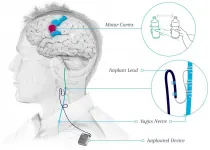
ELSE PRESS RELEASES FROM THIS DATE:
2021-04-26
A new study performed in human lung airway cells is one of the first to show a potential link between exposure to organophosphate pesticides and increased susceptibility to COVID-19 infection. The findings could have implications for veterans, many of whom were exposed to organophosphate pesticides during wartime.
Exposure to organophosphate pesticides is thought to be one of the possible causes of Gulf War Illness, a cluster of medically unexplained chronic symptoms that can include fatigue, headaches, joint pain, indigestion, insomnia, dizziness, respiratory disorders and memory problems. More than 25% of Gulf War veterans are estimated to experience this condition.
"We have identified a basic mechanism linked with inflammation that could increase susceptibility to COVID-19 infection ...
2021-04-26
During infection, SARS-CoV-2 binds to a cellular receptor known as angiotensin converting enzyme 2 (ACE2) before entering a cell and replicating. Because it is not well established whether common blood pressure medications can increase the levels of ACE2, there has been some concern that patients taking these medications might be more susceptible to COVID-19.
In a new study, researchers led by Hans Ackerman, MD, DPhil, in the Laboratory of Malaria and Vector Research (LMVR) at the National Institute of Allergy and Infectious Diseases, found that mice treated with an ACE inhibitor blood pressure medication showed increased levels of ACE2. However, mice that received both an ACE inhibitor and a different blood pressure medicine known as an angiotensin ...
2021-04-26
Tyrannosaurus rex dinosaurs chomped through bone by keeping a joint in their lower jaw steady like an alligator, rather than flexible like a snake, according to a study being presented at the END ...
2021-04-26
Thousands of livers donated for transplantation are discarded or turned down every year due to concerns about organ quality and function. New insights into why these organs are considered unusable and how they function during external perfusion could help save lives by greatly increasing the number of livers that are transplantable.
After a liver is removed from a donor's body, it undergoes a process known as perfusion which flows blood or a blood replacement though the organ's blood vessels to keep them open and active before the transplantation surgery.
"Our new findings will allow us to design therapies that could be used during external perfusion to improve the quality of organs so that these livers can be transplanted instead of being discarded," ...
2021-04-26
New research suggests a simple step could help millions of people reduce their risk of heart disease: make sure to get enough vitamin D. Elucidating linkages between skin pigmentation, vitamin D and indicators of cardiovascular health, the new study, combined with evidence from previous research, suggests vitamin D deficiency could contribute to the high rate of heart disease among African Americans.
"More darkly-pigmented individuals may be at greater risk of vitamin D deficiency, particularly in areas of relatively low sun exposure or high seasonality of sun exposure," said S. Tony Wolf, PhD, a postdoctoral fellow at the Pennsylvania State University and the study's lead author. "These ...
2021-04-26
The brain encodes information about our relationships and the relationships between our friends using areas involved in spatial processing, according to new research published in JNeurosci.
Humans maintain hundreds of social relationships, requiring the brain to catalogue countless details about each person and their connections to other people. But it is not known how exactly the brain stores all of this information.
To uncover how the brain encodes social network structure, Peer et al. used Facebook data to map out participants' social connections. Then the researchers measured their brain activity with fMRI as they thought about people from their network. Thinking about a connection generated ...
2021-04-26
A new guideline for reporting research results has been developed to improve reproducibility, replication, and transparency in life sciences.
The new Research Materials, Design, Analysis and Reporting (MDAR) Framework will harmonise the recording of outcomes across several major journals, its developers say.
Existing guidelines address specific parts of biomedical research, such as ARRIVE - which relates to animal research - and CONSORT, associated with clinical trial reporting.
The MDAR Framework - developed by a team from the University of Edinburgh, the Centre for Open Science and six major journal publishers - complements these by establishing basic minimum reporting requirements and best practice recommendations.
The Framework ...
2021-04-26
According to the Centers for Disease Control and Prevention (CDC), children generally appear to be less severely impacted by COVID-19 than adults. But a new study from Children's Hospital Los Angeles shows that the pandemic could be affecting children's health in unexpected ways. The study reveals a surge of patients presenting with diabetic ketoacidosis, a severe complication of type 2 diabetes. Published today in Diabetes Care, these data offer additional insights into how the pandemic may be impacting the nation's children.
Diabetic ketoacidosis, or DKA, is life-threatening. "DKA happens when insulin levels in the blood drop too low for too long," says Lily Chao, MD, MS, ...
2021-04-26
Like beauty, fairness is in the eye of the beholder.
In the workplace, whether or not we believe that a supervisor has treated us fairly depends on a number of factors, including motive, according to new research from the University of Notre Dame.
Employees evaluate the fairness of an interaction with an authority figure based on what researcher Cindy Muir (Zapata), associate professor of management at Notre Dame's Mendoza College of Business, describes as justice criteria or rules. These include relying on decision-making processes that grant employees voice and are consistent among employees, ethical and free of bias; treating team members with dignity, respect and ...
2021-04-26
JACKSONVILLE, Fla. -- A small study from Mayo Clinic researchers raises the concern that some transplant patients may have a limited immune response after being vaccinated for COVID-19 with an mRNA vaccine. Their findings are published as a letter to the editor in the American Journal of Transplantation.
The letter covers seven organ transplant recipients diagnosed with COVID-19 at Mayo Clinic in Florida six to 44 days after receiving either of the mRNA COVID-19 vaccines that have been authorized for emergency use by the Food and Drug Administration. Two patients had received one dose, and five patients had received both doses.
COVID-19 infection was confirmed in all patients with a polymerase chain reaction nasal swab test. The study team, led by Hani Wadei, M.D., ...
LAST 30 PRESS RELEASES:
[Press-News.org] Surgical procedure may help restore hand and arm function after stroke
International, multi-center clinical trial results provide new hope for patients even years after a stroke

